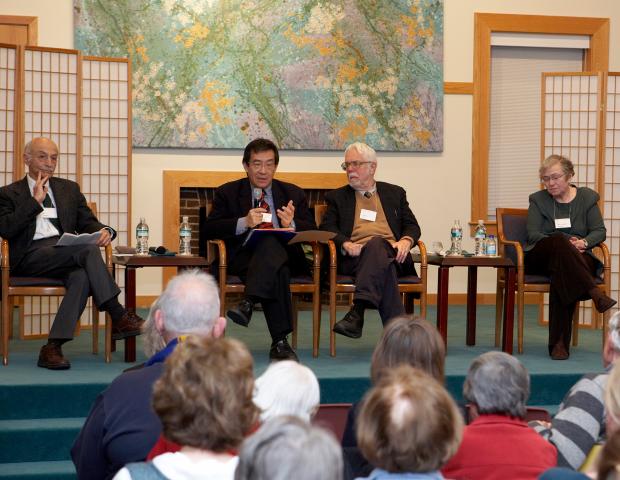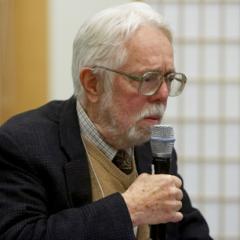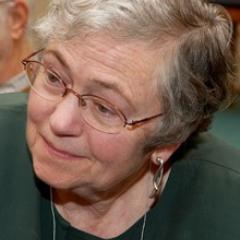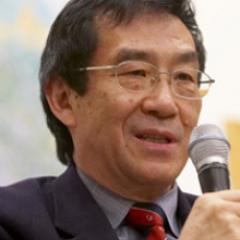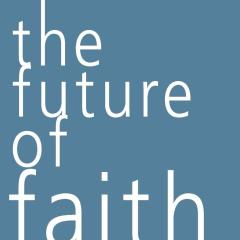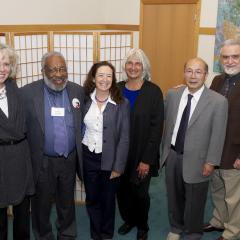Learning To Learn About Death
During 2008 the Center held a number of events in pursuit of a deeper understanding of death and dying. This article by Mitch Bogen reports on a February 2008 public dialogue held at the Center featuring Harvard professors Harvey Cox, Tu Weiming, and Nur Yalman along with cultural anthropologist and best-selling author Mary Catherine Bateson. The story also previews upcoming events also examining the topic of “Understanding Death, Appreciating Life.”
What does it mean for death to be more than “the absence of life”? How could it be possible to experience both life and death with “equal delight”? When Center founder Daisaku Ikeda raised these questions in his 1993 Harvard University lecture, they were destined to lead to a creative dialogue. But as it turned out, these questions would wait fifteen years to be explored in a structured way by the BRC.
Founded that same year, 1993, the Center has pursued, to date, a number of projects contributing to humanism and mutual understanding in our world: Multi-author books have stimulated interreligious dialogue on questions of violence and global economics. Public events have inspired ecological consciousness. The legacy of American idealists, humanists, and pragmatists, such as Emerson, Whitman, and Dewey, have been celebrated and examined in both seminar and book form. The cause of peace and justice has been cultivated in myriad programs.
But as the Center neared its fifteenth anniversary, the staff decided to return to those vexing questions raised in that “founding lecture” of 1993. Inspired by the passages above, they began plans to launch a public investigation into how we can develop a shared vision of death and dying that enhances our world. Executive Director Virginia Benson says, “Death and dying was a new realm for us, and it was not always easy.” The staff had to challenge themselves to figure out how to take these questions on and create a broad public dialogue around them.
Despite the challenge, “the timing feels right,” adds Benson. “First, there is the simple fact that the populous Baby Boom generation is entering a stage of life when the loss of parents, and even peers, is painfully immediate. Violent, large-scale death dominates the news, and we continue to witness the loss of entire species. Could it be that enlarging our understanding of life and death is the most significant step we can take now toward building peace in the world?”
Understanding Death, Appreciating Life
On the afternoon of February 27, the Center hosted a public dialogue featuring the thoughts and reflections of Harvard professors Harvey Cox, Tu Weiming, and Nur Yalman. Celebrated cultural anthropologist and author Mary Catherine Bateson offered deeply reflective opening remarks that framed the discussion. Called “Understanding Death, Appreciating Life,” the dialogue provided speakers and attendees alike with two questions to ponder: What has shaped your view of death, including personal experiences? How does your view of death affect the way you live?
Exploration was paramount. Though the main speakers had engaged in preliminary discussions prior to the event, they were asked only to think out loud in an atmosphere of mutual respect. Two powerful, related themes surfaced.
1. Given the right perspective and a willingness to learn, facing death and dying can humanize us.
“To be with someone who is dying is a profound learning how to love,” said Bateson. “I can think of no deeper learning of how to love than physically caring for my father during his dying. You know, maybe death and love are connected in some ways — part of what makes life so precious and so beautiful.”
To further illustrate death’s humanizing potential, Bateson told how she sometimes has students read a memoir of a gay man caring for his partner dying of complications from AIDS: “Students who were stuck in an old homophobic point of view came to me and said, ‘In reading that, I understood for the first time that two men or two women could form a relationship of true love’ — something they couldn’t empathize with before.”
Why do we have to wait until those last moments, or those last weeks, to shed those inhibitions, which, having shed them, we wish we had shed earlier?
Harvey Cox
Expanding on Bateson’s insights, Cox recollected his time as a young chaplain at Otis Hospital for the terminally ill in Cambridge, Mass. He was impressed with how the patients seemed so fully alive — so lucid, free, and straightforward. “They didn’t want to repress things, they didn’t want to delay things, and this was a lesson for me with reference to how I would live the rest of my life,” Cox said. He added that, in fact, all of us are in a “terminal hospital” of sorts, since we all must eventually face death. “It’s a rather pleasant hospice that we have here,” he said, but we’re in it nonetheless. So “why do we have to wait until those last moments, or those last weeks,” he wondered, “to shed those inhibitions, which, having shed them, we wish we had shed earlier?”
2. Still, death is a mystery and a loss. There is wisdom in acknowledging the pain of that loss and embracing that mystery.
In the Confucian tradition, said Tu Weiming, “when the question was asked, ‘What about death?’ Confucius responded, ‘We do not know life enough, how can we know death?’” Referring back to the example of the terminally ill patients, Tu speculated that it was not a vision of the afterlife that sustained them, but rather, their being part of a living, joyous encounter with fellow humans: “So there is only life that is being affirmed. It is not a spiritual sanctuary outside of the world that gives us solace.”
Others agreed that too much “spelling out” of an afterlife — for example, particular visions of heaven — might seduce us into denying and avoiding the pain that we feel when we lose those nearest to us. Speaking from the audience during the plenary session, peace scholar Elise Boulding followed up on points made earlier by Cox, noting that it is in artistic expression that we best honor the mystery of death and the full range of emotions we feel when confronted by it. Great works of art, she said, “bring out in us a feeling of the beauty of the cosmos; and grief can be beautiful, too; and sadness can be beautiful, too.”
This is not to say that there is no need for religion or structured ritual. Said Yalman, “I have found it a great source of peace to be able to allow myself to flow with the organized ritual of traditional form.” Because death produces such a tremendous amount of “inchoate emotion in oneself,” he said, great comfort can be gained by immersing oneself in a “community of loved ones, all of them participating in the activities that have been hallowed over the centuries.”
A Social and Spiritual Contribution
The personal aspects of the presenters’ comments sparked a strong sense of connection in the room, as did a twenty-minute discussion period during which audience members shared with one another their own experiences with death and dying. Adding to this atmosphere was the unexpectedly large turnout for the event, which also confirmed, said Benson, “that people definitely want to talk about death now.”
The gathering made a social and spiritual contribution, said one older couple as they were leaving the post-event reception. In their experience, they said, it is rare to engage in a discussion of death outside of a church congregation or some other gathering united by already-agreed-upon theological or cosmic frameworks.
In a sense, they were confirming the dialogical approach that is central to Ikeda’s vision for the evolution of humanity: When we come together for dialogue without pre-set answers, new possibilities present themselves. Perhaps, in the Center’s “owning” of death in open dialogue, we might move closer to a shared understanding of death and dying that is capable of fostering peace.
The Investigation Continues
Two events this fall will continue the exploration. In September, the Fifth Annual Ikeda Forum will feature the perspective of hospice care workers and others with intense, prolonged experience with death and dying. The goal, says Benson, is to “penetrate more deeply into the transformative process that takes place when one acquires a deep understanding of death. And so, what I think the public can look forward to is another opportunity, like they had in February, to talk in a public space — breaking the taboo about public exploration of death and then really connecting with other people.”
The second event, in October, will center on a lecture and related discussion with Yoichi Kawada, who not only serves as director of the Tokyo-based Institute of Oriental Philosophy but also holds a Ph.D. in immunology. Kawada, says Benson, will be illuminating some of the deeper implications of the view of death that Ikeda presented in 1993. Bateson will provide commentary, linking the lecture to the earlier events and contextualizing Kawada’s observations within her own integrated vision of death and life.
The February event movingly revealed how facing death might lead to an appreciation of life and a greater sense of shared humanity. The fall events will ask participants to reverse the equation: What is the attitude in life that can lead us to a true appreciation of death — and to that condition of “equal delight,” spoken of so provocatively by Ikeda fifteen years ago? Bateson planted some seeds of this approach during her reflections, when she challenged the participants to “make friends with death.” Pushing further, she said, “Somehow, you see, we need to be able to walk into the forest and see that all of its beauty is intertwined with the process of death feeding back into the life of the forest.”
